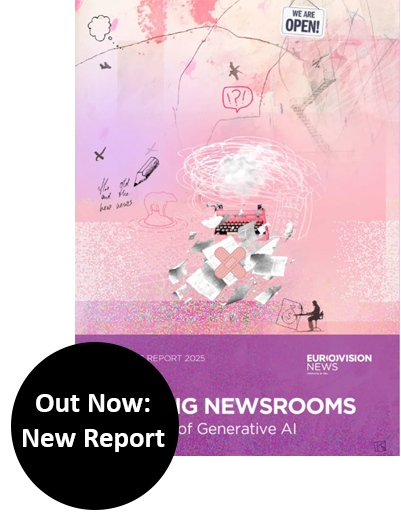The advances of generative AI have put those in charge of newsrooms on an emotional rollercoaster. While 2023 and 2024 were the years of reckless experimentation (“Hey, look what these models can do!”), in 2025, AI realism took over. Great ideas turned out to be hard to implement, costly, or solutions looking for problems (“Nice, but it’s not serving anyone!”). Putting strategy back into AI development became key.
This is why 2026 is likely to become the dip of the ride. Because now, the strategy needs to be filled with life. And while editors at media conferences widely agree that AI will force newsrooms to focus on unique, original journalism and experiences that create value for their audiences and deepen customer connections, some detailed data analysis will make many of them feel queasy. Because the result will often be not that different from what an editor recently revealed at an industry gathering: Only 5% of a subset of his brand’s content was original journalism. The subtext was clear, of course: The rest could have been done by an AI. Welcome to the 5% challenge.
Expect many newsroom leaders to become busy next year figuring out what exactly makes their brand stand out in the emerging sea of content. And even harder: finding a way to scale the 5% (or maybe 20%) to proportions that guarantee their journalism’s survival. Because let’s face it, the era of the web has been the age of copy-and-paste journalism. And this is exactly what (once) younger journalists have been raised to do in the past 20 years or so. Sitting behind the screen all day and competing for reach was the job. The word “reporting” — picking up stories from the streets by looking at things and talking to people, face-to-face or on the phone — was converted into the phrase “reporting on the ground,” which sounded as if leaving the comfort of the office was an award-worthy niche discipline.
For leaders, doing all of this will involve conveying some hard truths to many newsroom inhabitants: telling them that their daily work has to change — and fast. Converting agency copy into a snappy story — the AI has already done it. Doing some service journalism because customers safely clicked on it — the chatbot will have been there already. Upselling subscriptions with branded recipes — maybe, as long as ChatGPT still spoils the dish with hallucinations. Unfortunately, “stop doing” is among the hardest disciplines for any kind of enterprise. Because other than running exciting experiments and excelling in the innovation department, stopping routines and common practices is neither sexy nor does it bring about career advantages. To the contrary, it means robbing people of things they love to do, or are at least proficient in. And it takes away the status and power that was attached to practicing them. Speaking of rollercoasters, there will be some uncomfortable circles at the bottom of this.
There are four areas where media brands can scale the human-made part of their journalism
But here comes the uplifting part: Focusing one’s journalism on “the real thing” (again) will be fun — for seasoned hacks and creator-type newcomers alike. And it can also help bridge the newsroom generation gap. While younger colleagues can learn from the more experienced ones research and source-building skills for access and investigations (including persistence and picking up a phone), older ones will profit from everything that the Insta-and-Spotify generation can bring to the desk, like video, podcasting, data research, and brand-building competencies.
There are four areas in particular where media brands can scale the human-made part of their journalism: First, with strong personal brands who will play out their authenticity and humanness to connect with audiences (plenty has been published about news creators in 2025). Second, with deep expertise in niche areas that AI-generated content cannot provide because it is prone to converge around the average. Third, with investigations that make news consumers proud of “their” news brand. And fourth, with strong local journalism that is deeply rooted in its communities — in most cases, AI won’t go there. Creators who understand their formats and their stuff can figure in all of these areas, of course.
The sizable rest can safely be left to the workings of AI, where agents will do a much faster, more targeted, and personalized job than humans could have done, provided humans do the necessary prep work for accuracy. Markus Franz, chief technology officer of Munich-based Ippen Group, predicts that with agentic AI, the current “human in the loop” principle will be replaced with a “human on the loop” approach in the future that helps with scalability.
In all of these scenarios, journalism jobs will move into two quite different directions. One set of roles will lean toward the more techie side. They will need to shape the new AI-mediated world of journalism, ensure scalability that adheres to the quality standards of journalism, and build compelling products for customers that make them connect directly with the brand. On the other side, we will see the new “old-style” journalists who do everything to solicit exclusive information and/or establish themselves as personal brands. Talent will most likely have to pick sides early on, and it is essential that journalism education reflects and fosters this. As soon as everyone has settled into their new seats, the rollercoaster can go on its next climb.
This prediction was published with Harvard University’s Nieman Lab on December 16, 2025.




